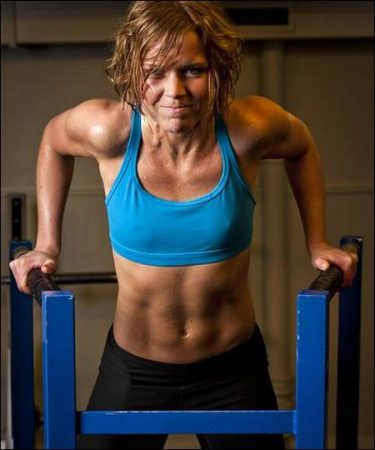The mechanical action of the levers employed determines the power which the muscle must exert to perform the work. Two factors influence the amount of power which a muscle can supply to its lever: variation in the strength of the pull resulting from different degrees of stretch of the working muscles and)the mechanical advantage of the lever. The position of a muscle at contraction affects the strength of the pull of the muscle.
The position of greatest pull is one in which the muscle is slightly stretched. The strength of the pull is decreased when there is no stretch on the muscle and, of course, there is no further strength in the muscle when it is completely contracted. The biceps is in the position for strongest pull when the elbow is fully extended and the biceps is stretched. The triceps is in position for the strongest contraction when the elbow is fully fixed and the triceps is stretched. When the elbow is fully extended the biceps pulls the radius and ulna against the humerus and only a small force is directed toward flexion of the joint.
With the elbow at half flexion (the lower arm at right angles to the upper arm), the force of the biceps is entirely employed in the flexion and the lever is in the position of maximal mechanical efficiency. With the elbow threequarters flexed the pull is again against the humerus and the efficiency of the pull is very low; also the biceps in this position is nearly fully contracted and possesses very little additional strength for movement of the lever.
If a heavy book is placed on the palm of the hand when the arm is extended along the top of a table, it may be observed that it is difficult to lift the book from this position. If the upper arm is raised to one-fourth flexion at the start of the lift, the lift is easier. The lift is easiest with the elbow flexed so that the upper arm is at a right angle to the lower arm, With the elbow fully flexed it is obviously impossible to lift the load father. The combination of these two factors, the advantage of the muscle stretch and the mechanical advantage of the pull from a right angle, allows a great percentage of the entire force to be exerted over a wide range of movement.
The range of movement in lifting heavy load is dependent upon the amount of the load and the degree of flexion at the start of the contraction of the muscles which are performing the lift. Loads which are near maximum can be lifted only short distances because of the reduced power when the joint is near full flexion or extension. To move a heavy load the greatest distance, start in the position at which the joint is flexed just to the point at which it is barely possible to move the weight.
Hits: 148
